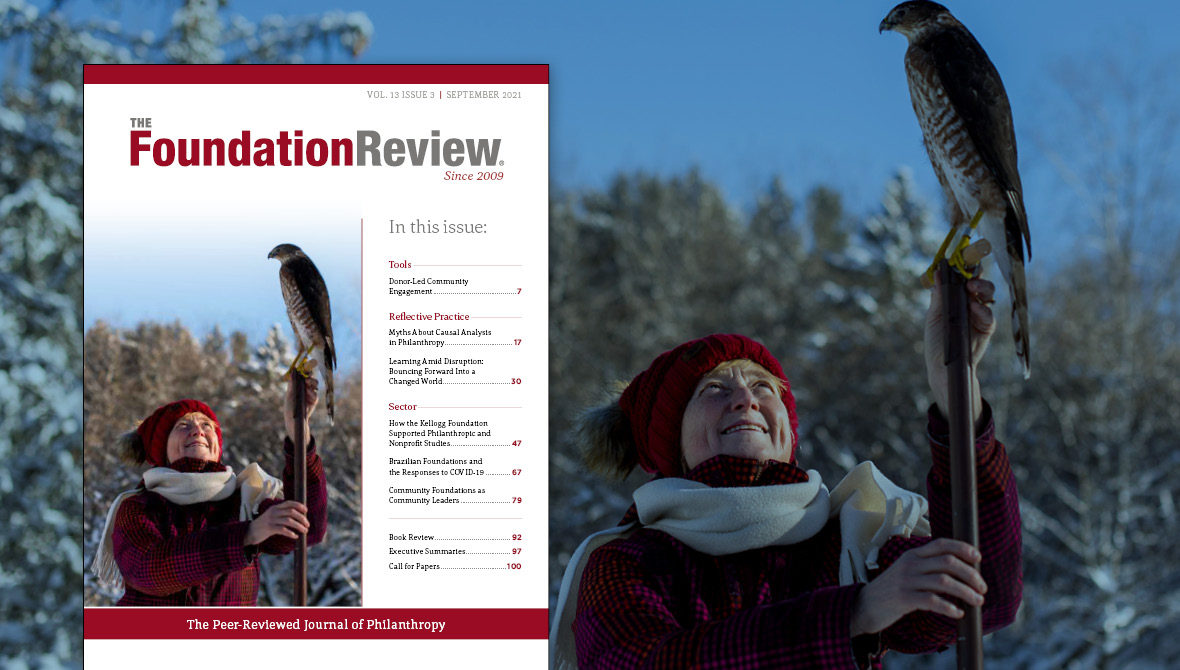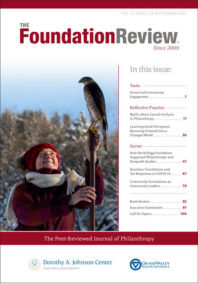Disruption, Innovation, and Impact


 I think of this issue of The Foundation Review as our pandemic issue. While we have an upcoming issue focused on how foundations responded to the pandemic, this issue was the most impacted by it.
I think of this issue of The Foundation Review as our pandemic issue. While we have an upcoming issue focused on how foundations responded to the pandemic, this issue was the most impacted by it.
Authors were working on these papers as their offices and their children’s schools shut down. Papers were submitted late, and reviewers had their own challenges in squeezing in time to thoughtfully read and give feedback.
Published months later than scheduled, this unthemed issue shares some exciting research and thinking. We hope you find that this issue was worth the wait.
In this article, Word and Gahre share insights learned from the work of the Wynn Resorts Foundation to support capital improvement projects. While capital funding is not new to philanthropy, this article describes an unusually high level of engagement by the foundation. They essentially project managed these capital projects and brought in other partners, leading to some long-lasting volunteer relationships.
One of the key questions in philanthropy is, “Are we making a difference?” While many of the issues that foundations fund are deeply rooted and require systemic change, Lynn, Stachowiak, and Coffman argue that philanthropy can be doing more to assess causality. Being able to clearly attribute change to what foundations funded and grantees did is often seen as impossible. The authors argue that there are more robust approaches to evaluation that should be more widely used that would enable a deeper understanding of causality.
The last two years have brought tremendous disruption to the philanthropic sector (along with the rest of society). In this article, Reichenbach, Lynn, and Heeg explore the journey Humanity United went through in 2020, focusing on the disruption as a moment to rethink how they might seek to change systems and adapt to emergence and unpredictability.
The Foundation Review exists to disseminate knowledge and improve practice in the philanthropic sector. As such, it is one of the signs of professionalization. An earlier step in this process of professionalizing the sector was the establishment of education programs focused on the sector. Weber and Long evaluated the impact of the W.K. Kellogg Foundation’s Building Bridges Initiative, a five-year program to fund nonprofit academic centers as a strategy to increase the nonprofit sector’s capacity. They found that the initiative advanced the institutionalization of nonprofit management education by legitimizing grantees both within and outside universities, supporting program delivery and expansion, and fostering collaborative networks.
Lucca-Silveira, Rodrigues, Jerabek, Kalvon Woods, and Vergueiro analyze the role of Brazilian foundations and their innovations during the COVID-19 pandemic. The authors suggest that foundations have been subject to three major innovations: the use of social intelligence for the provision of donations and social goods, new technology that can coordinate fundraising campaigns and mobilize civil society support, and shifts in the modus operandi of foundations.
Strawser explores the relationship between taking a leadership role and fundraising outcomes for community foundations. Based on interviews with leaders at 11 community foundations, he found that those that claimed a community leadership role were more successful in fundraising and had a higher profile within their regions than those that did not.
Volume 13, issue 3 concludes with a review of The Upswing: How America Came Together a Century Ago and How We Can Do it Again. Layton and Martin note that authors Putnam and Romney Garrett take a simultaneously broad and richly detailed look at the growth and decline of “community connectedness and social solidarity in America.” The issue of how the culture gets back to being a “we” culture is critical, and one that the philanthropic sector needs to understand and address.
Explore the full issue here. Not yet a subscriber? Click here to start your free 90-day trial.